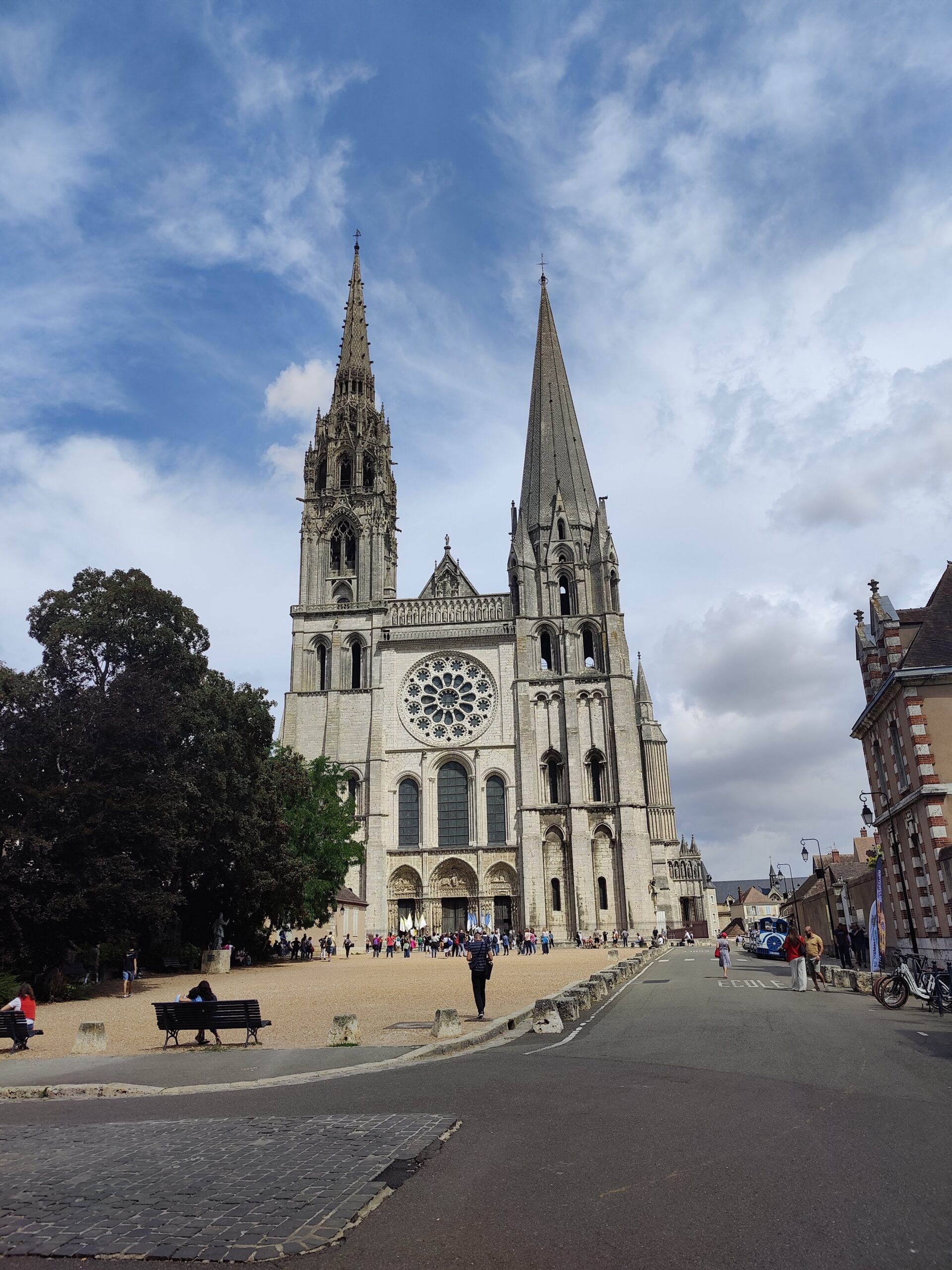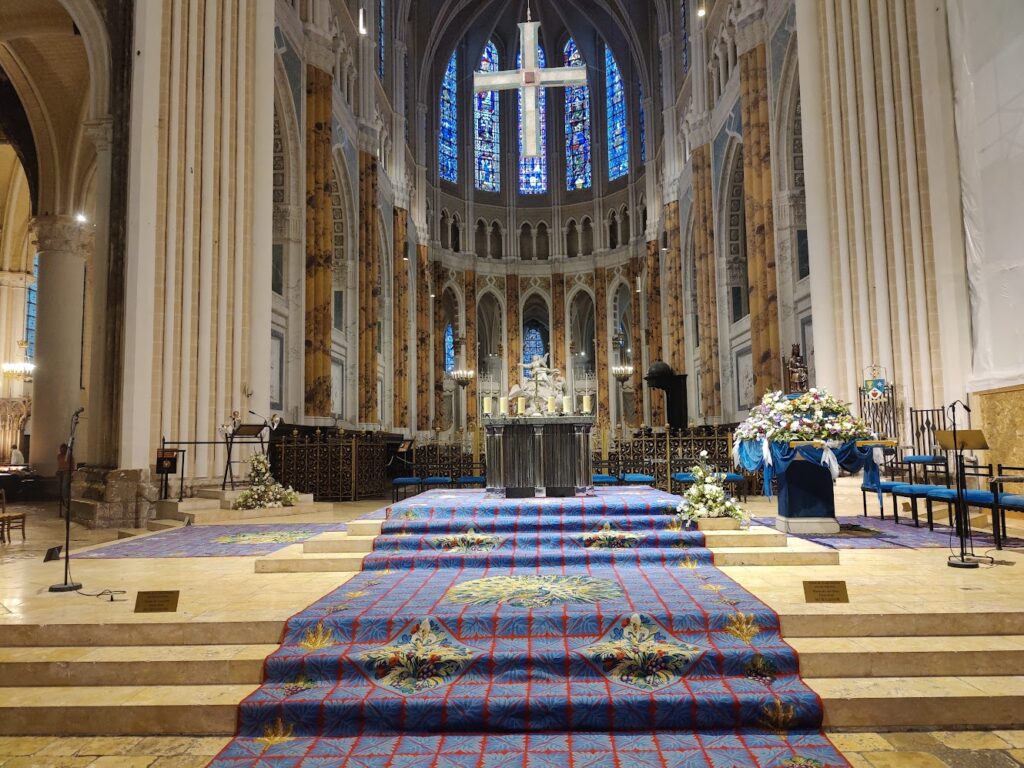Journey with Me Blog Series
Location: Chartres, France
My experience there
I have been in Chartres on several occasions, for weeks at a time, doing deep study and meditation both by myself and in group. At first, I had to overcome my familiar resistance to Christian places of worship. As someone born in the cradle of Catholicism, Rome, I have been exposed from a very young age to the constrictive, limiting aspects of religious formalism and have rejected them very early on. The imagery of Catholicism has been associated deep in my psyche with backwardness, limitation, even fear. Over the last decade, I’ve been patiently working to free myself from those unconscious associations. It is still a work in progress.
Yet Chartres, with its asymmetrical structure (the two frontal towers have different heights) and its rich iconography (you will find all kinds of things in Chartres, from old philosophers to monstrous creatures) has managed to enchant me in a way that perhaps no other church has.

The complexity of the symbolism inside Chartres is almost overwhelming. Each of its many stained windows could take you into a deep contemplation on its own. The statues, some of them original, some of them re-creations, tell stories that cross-reference one another in intricate ways. And perhaps the most significant symbol of the whole Cathedral, the Labyrinth, is hidden under rows of chairs!
Chartres is not “simple” — and I might have given up on her if it wasn’t for the support of my study group at Ubiquity University, and the privilege to spend an hour in Chartres every early morning when nobody else was around.
Today, Chartres stands proud as one of the most powerful architectural symbols of the Light Feminine. This family of archetypes, unlike its counterpart the Dark Feminine, is visible throughout Christian countries, but perhaps nowhere as clearly as in the French Cathedrals like Chartres itself and Notre Dame in Paris. The statues and windows in Chartres are rich with representations of the Virgin Mary, and even Mary Magdalene is present in one of its glass windows.
The statue of the Assumption of Mary in Chartres’ choir is perhaps the cleares symbol of the Divine nature of Mary—a status that she, unlike Jesus the Christ, had to basically fight for. Whether Mary was just a mortal woman or a divine being has been the subject of a bitter and heated debate in the first centuries after the establishment of the Catholic Church, a debate that became a true theological battle in the Council of Ephesus.
On some level, the fact that Mary is the main object of worship at Chartres, and that the statue representing her ascension into Heaven (called “the assumption”) reigns in the choir, is an achievement. But an achievement that doesn’t come without a price. Through her centuries-long spiritual ordeal, Mary the Mother of Jesus was indeed pronounced to be a divine being, the object of veneration, and the “mother of God,” but she was also declared to be immaculate and a “perpetual Virgin” before, during, and after giving birth. She has ascended to the Heavens, but she has lost much on the way: her humanity, her completeness, and part of her womanhood.
Chartres is a testament to the presence of the Light Feminine in her mighty, awe-inspiring, yet disembodied form. This is the way that most of us Westerners today relate to the Light Feminine.
Unlike some of the other sacred sites I share about, Chartres is a major place of worship visited every year by thousands of people from all around the world. In order to connect to its mystery and magic, one needs to move past layers of stratified meaning that have been loaded onto it over the centuries. So let’s have a quick look at Chartre’s history, between history and legend.
A little bit of history
Chartres is built on top of one of the major sites of worship of the Druids, the priestly class of ancient Celts. The Druids were known to prefer worship in sites of nature rather than building elaborate temples. The story goes that, on the hilltop of which the Chartres Cathedral stands, there used to be a grotto. When the Celts came to inhabit the area, they turned this grotto into a place of worship of an aspect of the Feminine energy: the life-giving, birthing Feminine.
In the 1st century AD, when the Gauls had already been conquered and annexed by the Roman empire, Chartres became the theater of important events following the Crucifixion: this is where Joseph of Arimathea is said to have landed after fleeing the Holy Land, and before moving on to what is currently England. Some versions of the story say that Mary Magdalene also traveled with Joseph, and unlike him, she stayed in France, giving rise to several strands of Christian mysticism that can still be found today.
The cathedral that we can see today—likely the fourth or fifth iteration, each of the previous ones having been destroyed by calamity or war—bears the spiritual and architectonic signature of Bishop Fulbert. Fulbert was a mystic deeply influenced by Platonic ideas, who not only rebuilt the Cathedral after the latest fire, but also founded a mystery school in it: the School of Chartres, which lasted for 200 years from around 1000 to around 1200 AD.
Under Fulbert’s guidance, Chartres became the most important medieval site for the Christian cult of Mary—a cult that was controversial, given the fact that Mary is given comparatively little space in the Bible, and that she is not recognised as an object of veneration in other Christian faiths such as Protestantism.
Without getting lost in the details of Chartres’ history, what’s important is that, through the enormous changes in society and religion that it traversed, Chartres remained a site of worship of the Feminine for more than two thousand years.
Thanks to the efforts of people like Fulbert, Catholicism has managed to retain some form of veneration of the Feminine—albeit a Feminine that has undergone a radical process of transformation and “purification.” Entering Chartres means immersing oneself in this process, which at the same time both exalts and transforms our understanding of the Feminine, sometimes in ways that can feel deeply disembodying and dehumanising.
The presence of the Black Madonna in Chartres’ crypt presents another fundamental layer of complexity to the question of how the Feminine is viewed, and treated, in Christianity. The Black Madonna may be seen as at least an acknowledgment of the Dark Feminine aspect of any integrated female deity. Yet, the worship of the Black Madonnas themselves is cryptic and left to the interpretation of our intelligence and sensitivity. Chartres today, after centuries of Christianity, is a place where the Light Feminine prevails, in her incompleteness, sure, but also commanding respect and devotion.
When you are there
Entering Chartres is very similar to entering an intricate, ornate book. There is a lot to see, and much of it is enshrouded in mystery or cryptic code. Just observing Chartres’ stained glass windows with any level of detail could take days.

Personally, I’ve always connected more to feeling, sensation, and sound, than to visual images. For me, the most profound experience in Chartres has been walking the labyrinth at the center of the church. This is, unfortunately, not an experience you’re likely to have on your own. Normally, the labyrinth is unceremoniously covered by rows of seats for the visitors and faithful. Only thanks to Ubiquity University have I had the possibility to step into the cathedral in the early morning, when nobody else is there, and walk the labyrinth after we had laboriously removed all the seats.
Chanting hymns to Mary the Mother of Jesus in Chartres, together with walking the labyrinth, is what I would love for you to do, challenging as it may be. Short of that, I invite you to visit the church, and contemplate the Black Madonnas in the main Church and in the Crypt, as well as the imposing statue of the Assumption of the Virgin Mary in the choir. Then, you will need to piece the puzzle by yourself, reconstructing the odyssey of the Feminine in a religion that has at times denied it, hid it, tried to cast it away, and in some way recovered it.
If you visit Chartres on August 15th, the day of the Feast of the Assumption, then you will have a chance to take part in a procession that ritually displays both the Black Madonna and the Santa Camisa, a piece of cloth supposedly of the vest that Mary was wearing when giving birth to Jesus. All the time, you will be surrounded by Catholic chants and, if you understand French, you will have a chance to hear a speech by the (obviously male) bishop.
The Feast of the Assumption itself, then, reflects all the rich contradictions of Catholic Christianity, a religious movement that has managed to secure a continued worship of a woman, Mary the Mother of Jesus, while depriving her precisely of her womanhood.
Christianity has in some sense locked our psyche in paradoxes: a Virgin Mother, a spiritual Conception, a bloodless Birth. This is not how our sexuality and reproduction works, and the difference couldn’t be more striking. If it may be difficult for men to feel identified with Christ, it is perhaps even more challenging for women to genuinely feel identified with the Virgin Mary. This is painful, because Mary undoubtedly brings some much-needed qualities of compassion, tenderness, emotionality, softness, to what could otherwise be an arid, sterile form of worship.
All of the above, however, makes it even more important to go to Chartres and find our own way in the spiritual labyrinth that it holds. Not by rejecting, but by entering the source code of such a complex spiritual history, can we hope to bring on some shift.

